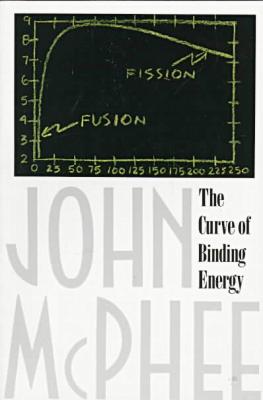

| THE CURVE OF BINDING ENERGY John McPhee New York: Farrar, Straus & Giroux, 1974 |
Rating: 5.0 High |
|||
| ISBN-13 978-0-374-51598-0 | ||||
| ISBN 0-0-374-51598-0 | 232p. | HC | $? | |
As a staff writer for the New Yorker magazine, John McPhee has written a number of books on a variety of subjects. Here, he presents a biographical sketch of the life of theoretical physicist Theodore B. Taylor. Drawing on extensive conversations with Taylor as well as interviews with his colleagues and teachers, McPhee takes us from Taylor's birth and childhood in Mexico City to his present position as a consultant on energy and environmental issues. Along the way, the young physicist joined the staff of Los Alamos lab just after World War II and designed some of the smallest atomic (fission) bombs ever built — as well as the largest, the so-called Super Oralloy Bomb or S.O.B.
As an insider familiar with many of the principals of Project Y, the Manhattan Project, Taylor understands the nuclear industry as few others do. His insights, presented here in very readable form, can be taken as a cry of alarm. It is not so much the existence of nuclear weapons that concerns Taylor (though he regrets his part in making them) but the proliferation of the materials from which they are made. For every power reactor produces a large quantity of plutonium-239, and this can be used for more bombs. Taylor is convinced, and convincingly argues, that almost anyone having some of this material — perhaps forty pounds — could without too much difficulty construct a crude A-bomb. His other great concern is that this material, which continues to accumulate in those nations operating nuclear power plants, is not being well-protected, even in the United States.(Indeed, there is some evidence that Russia stores and transports its reactor fuel more carefully than does the U.S.) Taylor estimates the stockpile will reach 10 million kilograms by the turn of the century. Such a large quantity makes minor losses highly significant.
The A.E.C., not surprisingly, insists that everything is under control. But McPhee's travels with Taylor as guide, quotes from other independent professionals, and a chilling 1973 GAO report on three storage sites, give the lie to this assurance. Ah, excuse me — they indicate that "That has been found not to be the case."
The A.E.C. can say officially that quantities of MUF [materials unaccounted for] are not dangerous. This is not so. Tons have been lost. They can say they have impregnable barriers, sensitive modern instruments. Not that impregnable, not that sensitive. – Charles Thornton, former head of Nuclear Materials Safeguards at the A.E.C. (p. 70) |
The A.E.C. approach is 'Papa knows best. Papa is guarding against every possible danger.' You look into it and find they are not. – Henry D. Smyth, former Manhattan Project scientist, former ambassador to the IAEA (p. 74) |
No scientist himself, McPhee makes some mistakes in translating Taylor's descriptions to the printed page. For example, on pages 132-3 Taylor gives a recipe for processing certain plutonium compounds to get a more usable form. McPhee quotes some prices, including that of magnesium oxide; but this was not one of the ingredients Taylor specified for that particular process. (It is called out later, as a paste to coat crucibles.)
More significant is the description of the eponymous curve of binding energy for chemical elements. McPhee on page 161 says that it rises with atomic weight for the lighter elements, peaks, and then descends again through the upper end of the list where the heavy elements like uranium are found. Thus, light atoms fuse to give up binding energy, while heavy atoms break apart with the same result. But this suggests that the graph is inverted; the middle should be the location of minimum binding energy.
Also, the yield of Little Boy, the Hiroshima bomb, is given as 13 kilotons; other sources say it is 19 or 21 kT. There are perhaps two or three other such goofs, not a large number for such a complex subject. Which is another way of saying that McPhee mostly gets it right. In any case, McPhee's writing is as clear and engaging as always. The book deserves to be widely read, not only for its important warnings, but for the description of Taylor's part in Project Orion and for its glimpses into the origins of the nuclear age.
However, a reference work it is not: There are no chapters (hence no table of contents), no index, no notes, and no bibliography. WRT this point, I think I remember a statement by Taylor giving a rule of thumb for estimating total Megacuries from bomb yield; but on searching the text I was unable to find it.

 To contact Chris Winter, send email to this address.
To contact Chris Winter, send email to this address.